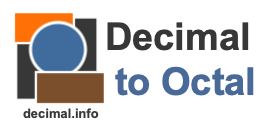
Here we will show you step-by-step how convert the decimal number 135 to octal.
First note that decimal numbers use 10 digits (0, 1, 2, 3, 4, 5, 6, 7, 8, and 9) and octal numbers use only 8 digits (0, 1, 2, 3, 4, 5, 6, and 7).
As we explain the steps to converting 135 to octal, it is important to know the name of the parts of a division problem. In a problem like A divided by B equals C, A is the dividend, B is the divisor and C is the Quotient.
The Quotient has two parts. The Whole part and the Fractional part. The Fractional part is also known as the Remainder.
To convert the decimal number 135 to octal, you follow these steps:
Step 1) Divide 135 by 8 to get the Quotient. Keep the Whole part for the next step and set the Remainder aside.
Step 2) Divide the Whole part of the Quotient from step 1 by 8. Again keep the Whole part and set the Remainder aside.
Step 3) Repeat Step 2 above until the Whole part is 0.
Step 4) Write down the Remainders in reverse order to get the answer to 135 as an octal.
Here we will show our work so you can follow along:
135 ÷ 8 = 16 with 7 remainder
16 ÷ 8 = 2 with 0 remainder
2 ÷ 8 = 0 with 2 remainder
Then, when we put the remainders together in reverse order, we get the answer. The decimal number 135 converted to octal is therefore:
207
So what we did on the page was to Convert A10 to B8, where A is the decimal number 135 and B is the octal number 207. Which means that you can display decimal number 135 to octal in mathematical terms as follows:
13510 = 2078
Decimal to Octal Converter
Need another decimal number as an octal number? How to convert 135 to octal is not all we know. Convert another decimal to octal below:
How to convert 136 to octal
Here is our next decimal to octal tutorial on our list.
Copyright | Privacy Policy | Disclaimer | Contact
